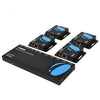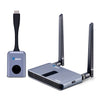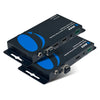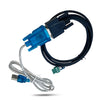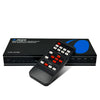
Digital connectivity changed how businesses handle audio and video. Legacy AV systems relied on fixed point-to-point wiring and hardware matrices that grew heavy and costly as systems scaled. Modern workplaces, classrooms, and venues need smarter distribution that can expand without ripping up the floor or wiring closets.
AV over IP answers that need by moving audio and video onto standard network infrastructure. This shift saves physical space and reduces long-term costs while bringing remote management and routing to the same tools IT teams already use. We expect this approach to gain steam where resilience, flexibility, and centralized control matter most. Readers following av over ip news today will notice this trend shaping the future of digital connectivity across industries.
What is AV Over IP?
The term AV over IP, or HDMI signal over ethernet, covers systems that send audio, video, and control signals as data packets across Ethernet networks. Traditional AV uses point-to-point links and matrix switchers. Modern setups replace those with encoders and decoders that turn HDMI into network traffic, allowing one source to reach many displays or many sources to be routed anywhere on the network. Those keeping up with av-over-ip news and audio over ip news have seen how rapidly these systems are replacing older architectures.
This architecture also appears as video over IP when the focus is on video distribution. Routing occurs in software or via a central control unit, which means layouts and routing maps can change without touching the cabling. The result feels more like managing files on a network than wrestling with hardware matrices.
How Does AV Over IP Work?
An AV over IP system starts with encoders, which take the original audio and video signals and turn them into compressed data packets that can travel across a standard Ethernet network. On the display side, receivers, also known as decoders, rebuild those packets into audio and video that look just like the original. A network switch connects everything together, directing the traffic and, if it supports power over ethernet switch capabilities, delivering power to the encoders and decoders over the same cable that carries the signal.
What makes AV over IP stand out is how it uses networking features to stay efficient. For example, multicast sends one video stream to multiple displays without clogging the network, while Internet Group Management Protocol (IGMP) snooping makes sure only the right screens receive it. Virtual Local Area Networks (VLANs) can keep AV traffic separate from everyday business use, and Quality of Service (QoS) prioritizes AV packets so audio and video stay smooth even on a busy network.
Because all of this is managed through the network, AV over IP systems are highly scalable. Adding displays, creating video walls, or routing content to new rooms becomes a matter of configuration rather than pulling new cables or buying expensive matrix switchers. That scalability is one of the major highlights seen in recent av over ip news october coverage.
Advantages of AV Over IP vs. Traditional Solutions
Scalability stands out first. Classic matrix switches grow expensive and bulky as port counts climb. An IP-based design lets teams scale to even thousands of endpoints using commodity switches. That means a single control interface can route any source to any screen without a physical rewire.
Cost-effectiveness also shows up in two ways. Initial spending can favor IP systems because Ethernet wiring and managed switches are often cheaper per port than dedicated AV cabling and large proprietary matrices. Long term, software-based changes cut labor costs. Upgrades become firmware or software updates instead of swapping routing hardware.
Flexibility also follows logically. An AV team can reassign sources, spin up zones, or commission a video wall through a central control panel. Features such as on-the-fly transcoding, networked recording, and remote monitoring integrate with existing networking solutions, which reduces training overhead and simplifies maintenance.
Lastly, reliability and manageability also improve. With AV over IP, centralized monitoring alerts admins to link failures and bandwidth issues before users notice, and remote firmware updates, scheduled reboots, and centralized logging make large installs manageable without frequent site visits.
Real-World Applications of AV Over IP
Corporate settings often use AV over IP for meeting rooms and campus-wide digital signage. One central system can feed lobby displays, huddle rooms, and a boardroom with different content at the same time.
Educational institutions benefit from networked lecture capture and flexible classrooms. Moving a guest lecture to a second campus or sharing a recorded class is a routing change instead of complex rewiring.
Hotels, retail stores, and entertainment venues use distributed content for advertising, wayfinding, and live events. A well-built IP system allows quick content swaps and multi-zone audio.
Control rooms and event spaces require resilience. AV over IP supports redundant paths, scheduled failovers, and simplified video wall management. High-density operations that used to need massive matrices now run on a mixture of encoders, decoders, and managed switches with centralized control. Introducing ToVi: OREI’s High-Performance AV Over IP Solution
Introducing ToVi: OREI’s High-Performance AV Over IP Solution
OREI created ToVi as a sub-brand focused on professional AV over IP deployments. The product line focuses on practical installs where scale and management matter most: corporate video walls, multi-zone distribution, and control rooms. ToVi products encode HDMI streams, carry control signals such as RS-232 and IR, and support USB KVM over the network, making them useful for both AV and IT teams.
Its features make ToVi attractive for integrators. With ToVi, encoders and decoders move video, audio, and control across a standard 1 Gbps network. A central control box handles routing, switching, and video wall layouts so installers do not need to rewire when the client changes the layout. For deployments that prefer a managed network stack, OREI supplies purpose-built 1G PoE switches that power endpoints over Ethernet while handling IGMP snooping and multicast efficiently. These switches simplify installation and reduce the number of power runs required.
ToVi’s approach also emphasizes support and reliability. Installers get tools for monitoring and managing the system from a single pane, and OREI backs ToVi with a 5-year warranty and lifetime technical support. That combination reduces operational risk for large projects where downtime has an immediate cost.  The Future of AV is ToVi
The Future of AV is ToVi
AV continues shifting toward IP because networks let teams scale, route, and manage audio and video the same way IT treats data. Solutions built on this model let organizations build larger, more flexible installs while cutting long-term costs.
ToVi brings these benefits to practical installs. For teams planning video walls, campus-wide signage, or multi-zone distribution, the platform simplifies design and ongoing management while leaning on standard Ethernet infrastructure. Learn more about how ToVi can fit your next project at OREI’s ToVi page.


